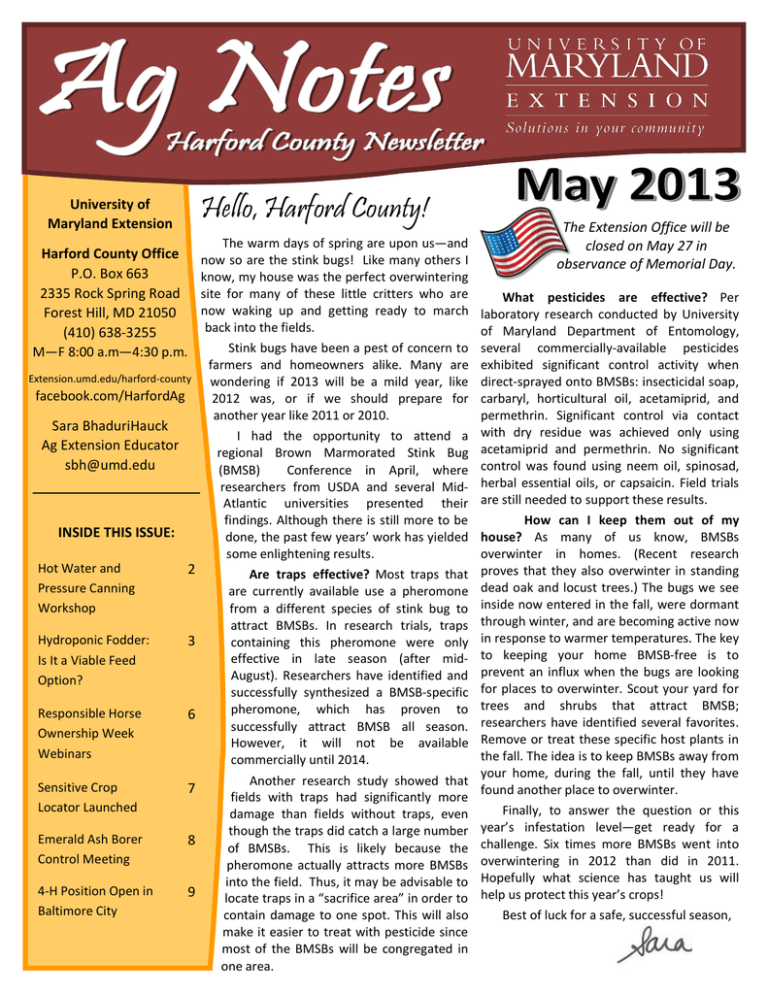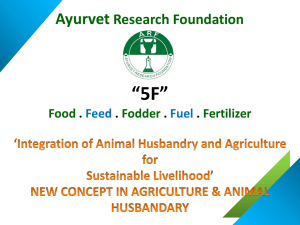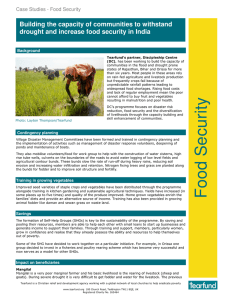Hello, Harford County! P.O. Box 663 University of Maryland Extension
advertisement

Hello, Harford County! University of Maryland Extension Harford County Office P.O. Box 663 2335 Rock Spring Road Forest Hill, MD 21050 (410) 638-3255 M—F 8:00 a.m—4:30 p.m. Extension.umd.edu/harford-county facebook.com/HarfordAg Sara BhaduriHauck Ag Extension Educator sbh@umd.edu INSIDE THIS ISSUE: Hot Water and Pressure Canning Workshop 2 Hydroponic Fodder: Is It a Viable Feed Option? 3 Responsible Horse Ownership Week Webinars 6 Sensitive Crop Locator Launched 7 Emerald Ash Borer Control Meeting 8 4-H Position Open in Baltimore City 9 The Extension Office will be The warm days of spring are upon us—and closed on May 27 in now so are the stink bugs! Like many others I observance of Memorial Day. know, my house was the perfect overwintering site for many of these little critters who are What pesticides are effective? Per now waking up and getting ready to march laboratory research conducted by University back into the fields. of Maryland Department of Entomology, Stink bugs have been a pest of concern to several commercially-available pesticides farmers and homeowners alike. Many are exhibited significant control activity when wondering if 2013 will be a mild year, like direct-sprayed onto BMSBs: insecticidal soap, 2012 was, or if we should prepare for carbaryl, horticultural oil, acetamiprid, and permethrin. Significant control via contact another year like 2011 or 2010. I had the opportunity to attend a with dry residue was achieved only using regional Brown Marmorated Stink Bug acetamiprid and permethrin. No significant (BMSB) Conference in April, where control was found using neem oil, spinosad, researchers from USDA and several Mid- herbal essential oils, or capsaicin. Field trials Atlantic universities presented their are still needed to support these results. How can I keep them out of my findings. Although there is still more to be done, the past few years’ work has yielded house? As many of us know, BMSBs overwinter in homes. (Recent research some enlightening results. Are traps effective? Most traps that proves that they also overwinter in standing are currently available use a pheromone dead oak and locust trees.) The bugs we see from a different species of stink bug to inside now entered in the fall, were dormant attract BMSBs. In research trials, traps through winter, and are becoming active now containing this pheromone were only in response to warmer temperatures. The key effective in late season (after mid- to keeping your home BMSB-free is to August). Researchers have identified and prevent an influx when the bugs are looking successfully synthesized a BMSB-specific for places to overwinter. Scout your yard for pheromone, which has proven to trees and shrubs that attract BMSB; successfully attract BMSB all season. researchers have identified several favorites. However, it will not be available Remove or treat these specific host plants in the fall. The idea is to keep BMSBs away from commercially until 2014. your home, during the fall, until they have Another research study showed that found another place to overwinter. fields with traps had significantly more Finally, to answer the question or this damage than fields without traps, even year’s infestation level—get ready for a though the traps did catch a large number of BMSBs. This is likely because the challenge. Six times more BMSBs went into pheromone actually attracts more BMSBs overwintering in 2012 than did in 2011. into the field. Thus, it may be advisable to Hopefully what science has taught us will locate traps in a “sacrifice area” in order to help us protect this year’s crops! Best of luck for a safe, successful season, contain damage to one spot. This will also make it easier to treat with pesticide since most of the BMSBs will be congregated in one area. New Fruit and Vegetable Headline News Available Fruit and Vegetable Headline News is published by University of Maryland Extension bi-weekly during the growing season. Check out the latest edition for stories on: Tree Fruit Disease Update High Density Apple Variety Fire Blight Resistance Trial Vegetable Transplant Height Control in Vegetable Crops Contact the Extension Office by phone or e-mail to receive a copy. Maryland Grain Producers Scholarship Given the dynamic changes in agriculture today, the advances in biotechnology, global positioning systems, biofuels, environmental protection, and crop and livestock production, Maryland’s grain farmers believe it is very important to encourage students to consider careers in agriculture by supporting their educational needs through scholarship. Eight awards in the amount of $2,500 will be presented to deserving applicants in 2013. Applicants must be a resident of Maryland and be enrolled or accepted to a 4-year institution working toward a B.S. degree, or enrolled or accepted to a 2-year institution within an agricultural program. The applicant or the applicant’s immediate family must be involved in the production of grain in Maryland. Applications are available online at www.marylandgrain.com. Completed applications will be accepted in hard copy or via e-mail to marylandag@gmail.com. The deadline is June 1. Winners will be announced, and are expected to participate, at the annual meeting on Thursday, July 25, 2013 at the Queen Anne’s 4-H Park on Route 18 between Queenstown and Centreville. Questions may be directed to 410-956-5771. Hot Water Bath and Pressure Canning Workshop A “Grow It, Eat It, Preserve It” program presented by UME Carroll County Attention 4-Hers: learn how to preserve your garden’s bounty, and go home with a project you can enter in the fair! The morning session will focus on hot water bath canning (9:30 to 12:00), and the afternoon session 9:30 a.m.—4:30 p.m. Harford Extension Office will focus on pressure canning (12:30—4:30). Please bring your own packed lunch. Sign up now! The class is limited to the first 15 paid Forest Hill, MD registrants. Registration is $15 per 4-Her. Adults may also attend the entire workshop for $65 or one session only for $35. Registration includes a copy of the publication It’s So Easy to Preserve. To register, call 410-386– 2760 or 1-888-326-9645. June 8, 2013 Hydroponic Fodder: Is It a Viable Feed Option? By Susan Schoenian, UME Sheep and Goat Extension Specialist (All photos courtesy of Susan Schoenian) Although the methods of hydroponic fodder production date back to the 1930's, there is renewed interest in hydroponic fodder as a feedstuff for sheep, goats, and other livestock. Hydroponics is a method of growing plants without soil. Only moisture and nutrients are provided to the growing plants. There are many advantages to hydroponics. Hydroponic growing systems produce a greater yield over a shorter period of time in a smaller area than traditionallygrown crops. There is a reduction or exclusion of pesticides and herbicides because the plants are in a more protected growing environment. Hydroponics is a year-round growing system that produces a consistent quantity and quality of plant material, regardless of outside weather. Fodder (livestock feed) can be grown hydroponically much the same as vegetables, flowers, and other plants. Hydroponic fodder systems are usually used to sprout cereal grains, such as barley, oats, wheat, sorghum, and corn, or legumes, such as alfalfa, clover, or cow peas. Barley is the most commonly grown forage, because it usually gives the best yield of nutrients (4). Forage mixtures are another option. A hydroponic fodder system usually consists of a framework of shelves on which metal or plastic trays are stacked. After soaking overnight, a layer of seeds is spread over the base of the trays. During the growing period, the seeds are kept moist, but not saturated. They are supplied with moisture and nutrients, usually via drip or spray irrigation. Holes in the trays facilitate drainage and the waste water is collected in a tank for recycling. The seeds will usually sprout within 24 hours and in 5 to 8 days have produced a 6 to 8 inch high grass mat. After the mat is removed from the tray, it can go into a feed mixer or be hand-fed to livestock. Livestock will eat the whole thing: seeds, roots, and grass. There is minimal waste. Livestock may not eat the fodder initially because it is novel, but they soon learn to eat it with relish. While it is possible to grow hydroponic fodder in any building, including a garage or basement, a greenhouse is ideal because temperature, light, and humidity can be precisely controlled. Efficient, year-round production of green fodder is not possible unless environmental conditions are optimal: approximately 70°F, 60 percent humidity, and 16 hours of light. For this reason, hydroponic growing systems usually require significant investment. Hydroponic fodder systems come in a range of sizes and capacities. Large fodder sheds may produce several tons of fodder per day, whereas a mini-fodder system may produce only 125 lbs. per day (3). It is possible to build your own system or a "turn-key" system can be purchased from a commercial company. Investments range from a few hundred dollars to six figures. As feed for livestock Fodder sprouts are tender and young, the equivalent of fresh spring grass. As such, they are highly palatable and nutritious to all types and classes of livestock. On an as-fed basis, hydroponic fodder compares favorably with other nutritious feedstuffs. At the same time, sprouting changes the nutritive characteristics of the grain. Enzymes breakdown storage components into more simple and digestible fractions; for example, starch to sugars, proteins to amino acids, and lipids to free fatty acids. There is an increase in fiber and some vitamins and a decrease in phytic acid, an antinutritional compound (11). There is a reduction in total energy. The increase in protein percentage is due to the dry matter loss . In fact, the downside to hydroponic fodder is its high moisture content. According to various forage analysis reports (3), the dry matter content of hydroponic fodder is only 12 to 15 percent, compared to almost 90 percent in (unsprouted) grains and hays (1). Even corn silage and haylage have considerably more dry matter than sprouts (1). If you do not consider its high moisture content, the per pound price of hydroponic fodder seems very economical, around $0.06 per pound (or $120 per ton) (3). Without further analysis, this sounds like a great way to reduce the cost of feeding livestock. But when the wet cost is converted to a dry matter basis, feed cost becomes very high. At 12 percent dry matter (DM), wet feed that costs 6 cents per pound actually costs 50 cents per pound of dry matter. This is considerably more expensive than most other feedstuffs, as shown in the tables below. the high moisture content of the feed, the high cost of the feed, and the scale which would be needed to produce sufficient dry matter (11). Animal performance The companies that market hydroponic fodder Comparative costs of different feed costs (as-fed) systems make all sorts of claims about green fodder as Feedstuff Cost Unit $/lb a superior livestock feed: better gain, improved fertility, earlier heat cycles, improved fleece quality, Barley sprouts $0.063 pound 0.060 improved immunity, better behavior and Orchardgrass hay $60 700-lb bale 0.086 temperament, less manure, etc. Few of these claims have been substantiated or proven to be repeatable in Alfalfa hay, mid $250 ton 0.125 experiments (5,11). bloom Over the years, in many different countries, and Barley grain $6 bushel 0.125 with different species (mostly cattle, pigs, and poultry), research trials have been conducted to assess the Soybean meal $480 ton 0.240 performance of livestock fed hydroponic green fodder (11). Across the many trials, there has been no Cost per pound of dry matter (DM) consistent advantage to including green fodder in the Feedstuff $/lb % DM1 $/lb DM diet of livestock, especially when it replaces highly Alfalfa hay 0.125 89 0.14 nutritious feeds, such as grain (5,7). Even if there are benefits to hydroponic fodder, the benefits are usually Barley grain 0.125 89 0.14 outweighed by the costs. Research is conflicting as to Orchardgrass hay 0.086 88 0.20 whether sprouting improves or reduces dry matter Soybean meal 0.24 91 0.26 digestibility as compared to the raw grain. In a 2012 journal article, Iranian researchers reported no Barley sprouts 0.06 123 0.50 increases in quantity or quality of dry matter and Because of its low dry matter content, the cost of nutrients with sprouting (10). While the companies nutrients in hydroponic fodder is also considerably claim that you'll get a 6 to 10-fold increase in weight more expensive than other feedstuffs. from a pound of unsprouted grain, they fail to mention Nutritional requirements of livestock are based on that the increase (in weight) is almost all water (5,11). dry matter intake. If fed to livestock at a rate of 2 At the same time, there is a strong need for more percent of their body weight (a common trials to determine the potential feeding value of recommendation), hydroponic fodder will only meet a hydroponic fodder, particularly with sheep and goats. fraction of most animals' nutritional requirements, Studies conducted in Italy in 2009 produced conflicting especially the higher producing ones. Thus, the fodder, results with regards to milk production and animal while excellent feed, is only a nutritional supplement welfare (2,8). Another aspect that needs to be and an expensive one at that. investigated is potential changes in the final product Full feeding of sprouts is usually inappropriate due to (meat and milk) as a result of replacing some of the animals' traditional diet with Energy (TDN) requirements met by feeding 2% fodder (as-fed) green fodder. Animal, stage of TDN requirements lb TDN supplied by % TDN requirements met by Other challenges lb DM/day1 fodder at 2% BW fodder production One of the biggest 154-lb. ewe, maintenance 1.36 0.52 38 challenges to producing hydroponic fiber, especially Late gestation, twin lambs 2.66 0.52 20 commercial quantities, is mold Lactation, twin lambs 2.88 0.52 19 (5, 11). Moldy sprouts can 132-lb. doe, parlor milked decrease animal performance 5.50 0.45 8 (10-14 lb milk/day) and result in animal deaths (5, Growth, 66-lb. lamb 11). Pre-treatment of seed with 2.18 0.22 10 (4 mos. old, 0.66 lb/day) a sterilizing agent (e.g. Growth, 44-lb. Boer buck hydrogen peroxide) is one 1.41 0.15 11 ( 0.44 lb/day) strategy for preventing mold. TDN supplied by fodder at 2% body weight was determined by multiplying body weight by 0.02. This figure was Good hygiene in the system is multiplied by the dry matter content of the fodder (0.12), then divided by the %TDN (0.71). Example: [(154 x also important. The growing 0.02) x 0.12] ÷ 0.71 = 0.52 lbs. TDN trays should be cleaned between crops with a chlorine based cleaning solution (11). Hydroponic fodder production requires a lot of labor. Time is needed to soak the seed, make up the nutrient solution, transfer the grain to the trays, load the trays onto the shelves, check the fodder daily for growth, remove the sprouted grain from the trays, wash and sterilize the trays, and feed the green feed to the livestock. Automation will reduce labor requirements, but may substantially increase investment costs. In order to create a controlled growing environment, it can require considerable energy to grow hydroponic fodder (5). Solar power could be used to provide electricity, especially in remote, rural areas or third world countries. Advantages of hydroponic fiber Hydroponic fodder has several environmental advantages over conventionally-produced fodder. Hydroponic fodder makes very efficient use of water (4,5,11). There is little waste water, as animals consume the recirculated water along with the feed. Since production is hydroponic, there is no leaching of nutrients into the environment. Hydroponic fodder production requires considerably less land to produce livestock feed. While hydroponic fodder is not likely to become a major source of feed for commercial livestock, it may be feasible under certain circumstances. Dry and drought-prone regions. Hydroponic fodder production is probably best-suited to semi-arid, arid, and drought-prone regions of the world. By growing fodder indoors, crop failures would no longer be a risk. Good quality forage could be produced year-round. Feed supplies would be insured. Scarce water resources could be allocated more efficiently (4). Limited land. In places where land values are extremely high or land is simply not readily available, hydroponic fodder has obvious advantages, as it can be produced in a small footprint. Because the fodder is produced continuously, there is no need for long-term feed storage and no nutrient losses that can be associated with feed storage. High alternative feed costs. While this article clearly shows that hydroponic fodder is considerably more expensive than conventional feedstuffs, it assumes that conventional feedstuffs are available and priced competitively. There are many locations in which this is not the case and hydroponic fodder could be more competitively priced, especially if animal performance is improved, due to unknown nutritional factors in the green fodder. Small-scale producers. Requiring smaller amounts of fodder, small-scale producers may be able to build their own fodder systems for a few hundred dollars. When the investment is low and labor is unpaid, the cost of hydroponic fodder is more reasonable. Non-ruminants. Hydroponic fodder may be bestsuited to non-ruminants (horses, rabbits, pigs, and poultry) who would benefit more from the changes in the feed due to sprouting (e.g. less starch, more sugars) as compared to ruminants (sheep, goats, and cows) who are less efficient at digesting high quality feed (6). Hydroponic fodder seems ideal for horses, though the research is lacking. A study with rabbits showed no detrimental effect to replacing up to 50 percent of the commercial diet with green fodder (9). Organic. Hydroponic fodder production seems particularly well-suited to organic producers (6), who already pay high prices for feed or have difficulty sourcing organic feedstuffs. Cereal grains can easily be sprouted in accordance with USDA's Certified Organic Program. In the future As competition for land and water increases and feed prices continue to rise, hydroponic fodder could become a viable option for more livestock producers. References 1 Nutrient Requirements of Small Ruminants (2007) - National Research Council 2 Evaluation of animal welfare and milk production of goat fed on diet containing germinating seeds (2009) - Italian Journal of Animal Science 3 Fodder Pro (FarmTek) (2012) 4 Green fodder production and water use efficiency of some forage crops under hydroponic conditions (2011) - ISRN Agronomy 5 Hydroponic fodder production: an analysis of the practical and commercial opportunity (2011) - The New Zealand Merino Company 6 Hydroponic fodder systems for dairy cattle (2013) - Iowa State University 7 Performance of feedlot calves fed hydroponics fodder barley (2011) - J. Ag. Sci & Tech 8 Improvement of sheep welfare and milk production fed on diet containing hydroponically germinating seeds - (2009) Italian Journal of Animal Science 9 Productive response of rabbits fed with green hydroponic oats forage as partial replacement of commercial concentrate (2011) - Acta Agronomica 10 Productivity and nutritive value of barley green fodder yield in hydroponic systems (2012) - World Applied Sciences Journal 11 Review of hydroponic fodder for beef cattle (2003) - Meat & Livestock Australia Responsible Horse Ownership Week Webinars May 13-17, 2013 Mark your calendars for the University of Maryland Webinar series! As part of Responsible Horse Join us each day at noon! Ownership Week, sponsored by the Maryland Fund for Horses, a variety of topics will be presented at 12:00 pm each weekday. All webinars will be recorded and placed on our website at extension.umd.edu/ horses/resources/recorded-webinars for future viewing. May 13: “What Supplements Does My Horse Need?” by Dr. Carey Williams, Rutgers University May 14: “Broodmare Nutrition” by Dr. Tania Cubitt, Performance Horse Nutrition May 15: “Managing Your Horse’s Joint Health for Lifetime Soundness” by Dr. Linda Dahlgren, VA-MD Regional College of Veterinary Medicine May 16: “Parasite Control and Resistance” by Dr. Harold McKenzie, Marion DuPont Scott Equine Medical Center May 17: “Understanding the Horse’s Hoof” by Mike Poe, Associate of the Company of Worshipful Farriers and Certified Journeyman Farrier Registration is free and open to anyone; a computer with high-speed Internet access is required to view the webinars. Register in advance by visiting agnr.umd.edu/seminars in order to receive login instructions. Questions may be directed to Jennifer Reynolds at jenreyn@umd.edu or 301-405-1547. “Focus on Corn” Resource The phrase “nip the problem in the bud” probably had its beginnings in agriculture, and it certainly applies in early season corn management! Across the U.S., early season weed management is critical to stand establishment and protecting yields. And in the Mid-Atlantic region, where more growers are practicing no-till, slugs are becoming a major issue. As part of its mission to enhance the health, management, and production of corn crops through quality, science-based information, the Plant Management Network has published two new early season management webcasts in its “Focus on Corn” resource: “Slug Management on Corn,” by Dr. Ron Hammond, and “The Importance of Early Season Weed Management in Corn,” by Dr. Mark Loux, both from the Ohio State University. These presentations are open access through the end of June, 2013. These and other “Focus on Corn” Presentations can be viewed at www.plantmanagementnetwork.org/foc. Crop Insurance Early and Final Planting Dates These 2013 dates are specific for Harford County, provided by USDA-RMA. Corn Soybeans Early April 11 Final June 10 Early April 15 Final June 20 Harford County Weed Control Program The Harford County Weed Control Program, in cooperation with the Maryland Department of Agriculture, is available to assist farmers in controlling noxious weeds on their properties. Noxious weeds in Maryland include thistles, Johnsongrass, Shattercane, and multi-floral rose; by law, these weeds must be controlled. The Harford County Weed Control Program will provide hand gun spot spraying for these weeds in pastures, crop fields, fence rows, building lots, and non-crop areas. The spray charge for farm properties is $45.00 per hour plus material. For more information, contact Nathan Anderson, coordinator, at 410-776-1526 or Jim Calao, MDA Representative, at 410-841-5920. MDA’s Sensitive Crop Locator Launched The Maryland Department of Agriculture has launched a new online mapping application, called a “Sensitive Crop Locator,” where pesticide applicators can see locations of crops sensitive to pesticide damage so they can take extra precautions to prevent drift, especially from herbicides, when spraying on nearby properties. Crops sensitive to damage include grapes, tomatoes, organic farms, tobacco, livestock, nurseries, and vegetables, among others. The map can be accessed from the MDA website, www.mda.maryland.gov, under “Hot Topics.” The map includes the name and address of the grower; the type of crop/commodity produced; contact information; and the specific location where each crop is grown. Commercial growers who want their crop and/or commodity listed can submit an application to MDA for each field to be listed on the website. For more information or to obtain an application, contact MDA’s Pesticide Regulation Section at 410-841-5710. Buffer Zone Calculator for Soil Fumigant Applicators An electronic Buffer Zone Calculator is now available in EPA’s online Soil Fumigant Toolbox. The EPA developed this new tool to help soil fumigant applicators, growers, and enforcement personnel determine the buffer zone distances now required by soil fumigant product labels per label changes that became effective on December 1, 2012. The Buffer Zone Calculator is specific to each fumigant product and is based on lookup tables on the product labels. A guide for applicators explaining how to calculate buffer zones manually is also available in the Soil Fumigant Toolbox. To access these online tools, visit http://www.epa.gov/ pesticides/reregistration/soil_fumigants/index.htm. Woodland Webinar The next webinar in the Woodland Stewardship 12:00 p.m.—1:00 p.m. Education, Woodland Wildlife Series will be “Ecology and Management of Young Forest Wildlife,” presented by Tom Mathews, habitat biologist from The Wildlife Management Institute. The decline in young forests and early successional environments has led to a decline in several important species, such as the American Woodcock. A high-speed Internet connection is required to participate. It is suggested to connect 10-15 minutes before the webinar begins: con n ec t. mo o.u md. ed u/ umeforestry and log in as a guest. May 9, 2013 Photo: Bruce Yolton Emerald Ash Borer Meeting May 7, 2013 “Planning for the Invasion: Con trol Measures for Emerald 9:00 a.m.—3:00 p.m. Ash Borer” will show Robinson Nature Center municipal and county Columbia, MD officials why they need to begin the EAB planning process as the invasion continues to spread throughout the state. The workshop will feature a hands-on demonstration of control techniques. This meeting will count for MD pesticide applicator recertification (categories 2 and 3A) and 5 MD/DE Master Logger CE credits. For more information, complete agenda, and registration, visit eabcontrol.eventbrite.com. Registration is $30/person. Photo: Canadian Food Inspection Facility Pre-Sidedress Soil Nitrate Testing: Crucial for Corn! By Patricia Hoopes, Nutrient Management Advisor When growing corn grain or corn silage, soil nitrogen levels are very important for crop health and yields. Fertilizer recommendations, generated for a field that had a previous forage legume crop or manure application, assume a significant nitrogen contribution from the previous crop or manure application. Nitrogen is not a stable compound and there are many factors that can affect the amount that is actually present when the plant needs it. 2) Manure or biosolids have been applied this year or in the past two years, OR a forage legume was grown in the previous year. 3) Less than 50 pounds of commercial fertilizer nitrogen per acre was applied prior to testing. Do your crop recommendations depend on a nitrogen credit from an organic application or a previous forage legume crop? Are you applying less than 50 pounds of nitrogen per acre in your starter fertilizer? If this scenario describes your corn field, it is highly recommended that you schedule a PSNT study to evaluate the nitrogen levels at this critical time. test done to ensure the advisor’s availability. It is also recommended that growers alert their advisors prior to the 6 inch stage. Corn grows quickly during this critical time, and scheduling can be challenging. PSNT is not applicable when: 1) More than 50 pounds of commercial fertilizer nitrogen has been applied to the field. 2) Commercial fertilizer has been the only nutrient The PSNT test takes the guess work out of nitrogen source. availability. This test determines how much nitrate 3) Irrigation is used. nitrogen is present in the soil at a critical time. When When should this test be done? the results indicate that the nitrogen level is This test must be run when the corn is between 6 and satisfactory, the grower is saved from any more 12 inches tall. If the corn is over 12 inches tall the test financial inputs. However, when nitrogen levels are cannot be completed because results will be invalid. It found to be too low, nitrogen can be side-dressed at a is recommended that you let your nutrient rate to ensure an adequate crop. management advisor know now that you will want this Qualifications for PSNT testing: 1) Corn silage or corn grain is being grown. For questions on the PSNT test or to schedule testing for your fields, call Tricia Hoopes, Nutrient Management Advisor, at the Harford County Extension Office, 410-638-3255. 4-H Position Open in Baltimore City University of Maryland Extension is hiring a Faculty Extension Assistant for 4-H programs in Baltimore City. Applicants must have a bachelor’s degree in science, technology, engineering, math, youth development, or education. Preference will be given to applicants who have experience with volunteers and youth. The base salary for this position is $32,640. All candidates must apply online at ejobs.umd.edu; search for faculty position number 117685. Applications will be accepted until a suitable candidate is found. Harford Soil Conservation District Supervisor Sought Nominations for an appointment to the Harford Soil Conservation District Board of Supervisors are being accepted by the Maryland State Soil Conservation Committee. The appointment will be for a term to expire October 17, 2016 and will fill the unexpired term of Michael S. Birch. Nominations should be sent to: State Soil Conservation Committee, Department of Agriculture, 50 Harry S. Truman Parkway, Room 306, Annapolis, MD 21401. Any interested individual or organization may submit a recommendation. Nomination forms are available at the Harford County Extension Office. Forms may also be picked up at the Harford Soil Conservation District Office, 19 Newport Drive, Ste. 103, Forest Hill, MD 21050 or online at www.mda.maryland.gov (click on Conservation, then Committees). Nominations should be received by the State Soil Conservation Committee by May 30, 2013. A supervisor must be a resident of the district. District boundaries are the same as county boundaries. Anyone recommended should be able to attend monthly meetings of the Board of Supervisors and have a knowledge of and sincere interest in proper land use and the conservation of soil, water, and related natural resources. Farmers Market Listing The 2013 Maryland Farmers’ Market listings of locations and hours for each of the state’s markets is now available through the Maryland Department of Agriculture (MDA) website. This year, some 131 markets will be open with at least one in every county and Baltimore City. To view the 2013 Farmers’ Market Directory, visit mda.maryland.gov/ maryland_products/Pages/farmers_market_dir.aspx. A searchable database of farmers’ market locations, hours, and producer/vendor and product listings is available on the Maryland’s Best website at www.marylandsbest.net. The print version of the 2013 Maryland Farmers’ Market Directory will be available in mid-May from MDA’s Marketing Division at 50 Harry S. Truman Parkway in Annapolis, 410-8415770. Jeff Myers Area Extension Director Harford, Baltimore, and Carroll Counties Sara Meagher BhaduriHauck Faculty Extension Assistant Agriculture and Natural Resources Dairy Breed Field Days The 2013 Dairy Breed Field Day schedule and entry form document is now available online (dairy.umd.edu) in a fillable PDF format. Questions regarding the shows or the entry form can be directed to Kiera Finucane at kieraf@umd.edu or 301-405-1392. sbh@umd.edu harford.umd.edu facebook.com/HarfordAg The University of Maryland Extension programs are open to all citizens and will not discriminate against anyone because of ra ce, age, sex, color, sexual orientation, physical or mental disability, religion, ancestry, national origin, marital status, genetic information, political affiliation, and gender identity or expression.




